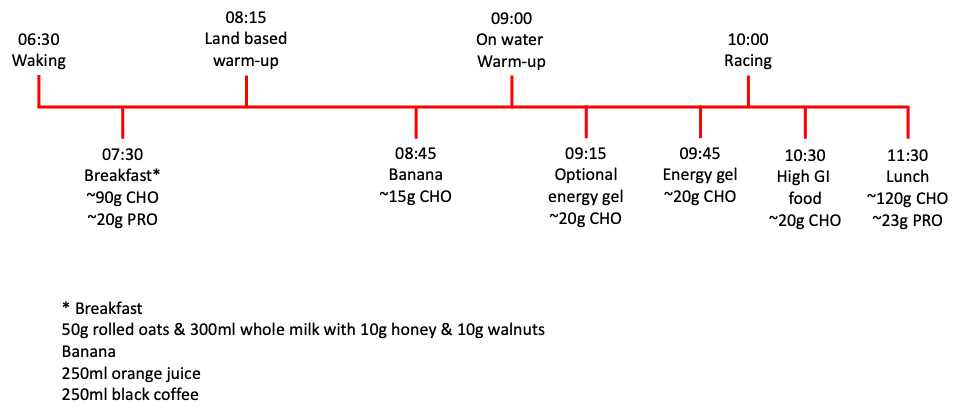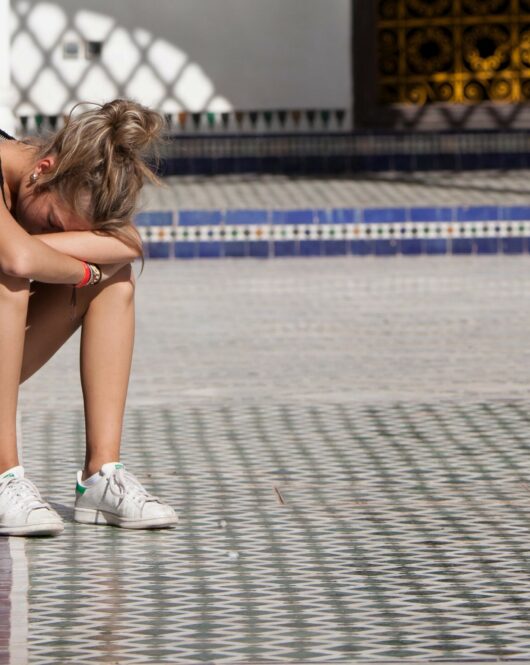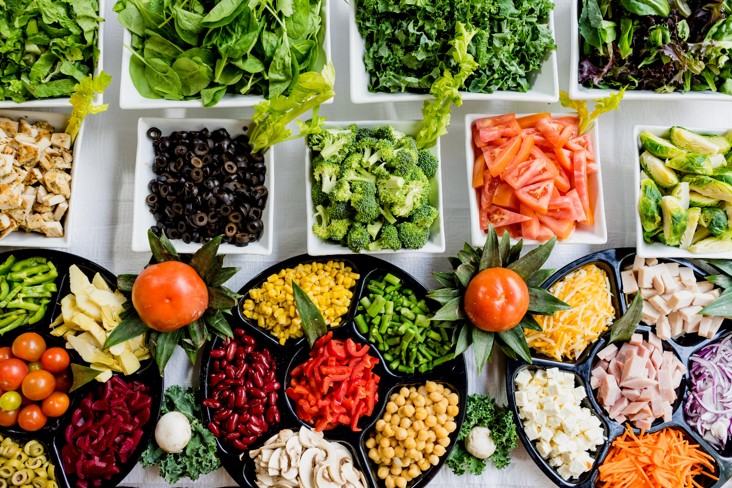Rowing nutrition can often be overlooked because of the focus being on the training and competition itself. We all probably know having an ideal diet for rowers is likely to be helpful with performance, regardless of level, yet my observations would suggest it is still not given enough attention. So, what really is the best diet for rowers? To answer this, we need to explore some important topics around this before we can really answer this.
The importance of diet for rowers
There are three important areas, which regardless of sport, athlete or level must be considered. These are:
1. Training or competition
2. Type of training
3. Objectives of nutrition
The first is probably the simplest and most logical factor that most of us will have considered. The event and training for the event have entirely different energetic and metabolic demands. A 2000m race can last upwards of 5 minutes, with a large mix of energy metabolism coming from both aerobic and anaerobic pathways. The early and latter parts of the race may be predominantly anaerobic in nature meaning energy is derived from metabolic pathways in the absence of oxygen so is reliant on stored energy sources such as muscle and liver glycogen and muscle phoso-creatine. While pre-race nutrition can support the aerobic energy metabolism during a race, the stored energy sources are unlikely to be significantly affected with what is consumed prior to racing. These stores are developed over chronic training cycles. For the diet of rowers to have an impact on race day, how we train and organise our nutrition over the days, weeks, and months before competition can influence the impact this has.
The goal of training is to optimise the adaptive responses elicited from the training itself. These adaptations are required for rowers to make the boat go faster. Most adaptations are likely to be made from training methods outside of what the event itself looks like. For example, to increase blood volume and increase aerobic enzyme activity, longer steady state training will be required. To increase the knee extensors maximal force expression, heavy resistance training will be required. The volume and diversity of training far outweighs that of competition, whether that is a single race or multiple rounds of racing over several days. Therefore, the optimisation of training adaptation is as critical as the optimising on day rowing performance. When working with athletes of any sport, one of the biggest factors that will positively or negatively impact the adaptive training response is the quality and timing of nutrition. It doesn’t matter how good the training is to elicit the desired training outcome, if effective rowing nutrition is not in place, that adaptive response and training outcome will be blunted. This naturally leads to a position of asking, why effectively train without effective supporting nutrition? Crudely, what may take 6-10 sessions to gain the desired training outcome over a couple of weeks, may take 12-20 sessions to gain without effective supporting nutrition. Why would anyone train more to get the same outcome as training less with an excellent diet for rowers? Rowing nutrition is so potent in training (and performance), it simply cannot be overlooked.
The diet for rowers is something we have huge control over and can make a significant impact on what will result in improvements in training and competition. Knowing where to start is often the challenge for effective diets for rowers. It is worth exploring the key objectives for rowing nutrition.
Objectives for Rowing Nutrition
We can break down rowing nutrition down to three key objectives:
1. Fuelling- Refuelling
2. Hydrating- Rehydrating
3. Building-Rebuilding
Fuelling-refuelling refers to the availability of energy. While all macro-nutrients are an energy source, fuelling and refuelling refers mostly to the consumption of carbohydrate prior, post and sometimes during training and competition. Carbohydrate is a rapid energy source. Once ingested, it can be metabolised into energy that will be used by the working muscles and the brain. This is often the objective most rowers will do more effectively than the others. Having fuel available to complete the required training or competition will be paramount both for performance and optimisation of the training stimulus for adaptation. We must fuel effectively prior to the session or competition, fuel during training if the duration is long enough to warrant its need and post training. Effective fuelling [post training session] also ensures we are ready for the next training sessions; this becomes more important if we are training multiple times within a day.
Hydrating-rehydrating refers to the repletion and / or maintenance of fluid. Fluid loss is mainly through sweating. Any loss of fluid needs to be replaced through drinking water or electrolyte fluids. Fluid loss, if ignored, can result in dehydration, where the loss of fluid is greater that the fluid consumed. Dehydration can have significant effects on performance with fluid losses as little as 2% of body mass. This is important for both training and optimising training adaptation and rowing performance itself. Dehydration can also significantly impair cognitive function too, such as attention, which maybe important for tactical racing.
The final objective of building-rebuilding refers to the cellular adaptive response to training and through an optimal diet for rowers. While carbohydrate provides the energy to allow a rower to perform the training required to create to stimulate the adaptive response, it is protein which is the building block of the adaptive response. Protein is the only macronutrient that can stimulate muscle protein synthesis (MPS) which is critical for changes in muscle strength and hypertrophy. Protein is also required for aerobic training adaptation, specifically mitochondrial biogenesis, which are organelles involved in aerobic respiration and energy metabolism. My experience over a decade working with rowers highlight protein is often the most overlooked nutrient within diets for rowers and is often not consumed in enough quantity to truly support the aerobic and anaerobic adaptations required to improve rowing performance.
A Plant-Based Diet for Rowers…
A side note to protein is its source. It has been long believed that for optimal MPS to occur and changes in strength characteristics, animal-based protein must be consumed. This is because plant-based proteins are incomplete, in that they will be missing one or more essential amino acids. This has led many to believe that incomplete protein sources cannot be as effective in promoting MPS or supporting changes in strength characteristics. However, a recent study has shown that MPS and strength gains are nearly identical regardless of the source of protein (Hevia‑Larraín et al 2021). Plant based protein was as effective as animal-based protein. There has been a fairly large stigma until recently with plant-based diets and the perception that those using one cannot adapt or perform as well. My experience of both athletes I have worked with plus my own personal experience of moving to a more plant-based diet does not support this stigma but significantly closer to the available evidence. The fuelling-refuelling and hydrating-rehydrating objectives are easily attainable regardless of being plant based or animal based. This demonstrates that those on plant-based diets can equally optimise training adaptation as meat-eaters. Any resistance to the contrary is likely to come from a position of being ill-informed of recent literature, or from an availability bias, where information used to make a decision is from readily available information rather than information that is factually correct and representative of the facts.
Knowing the three key objectives of rowing nutrition helps us to build supporting strategies for both training adaptation and competition performance. You may have read to this point thinking this makes sense but what does this really look like for me. Let’s look at each of these in turn.
As highlighted earlier, we need to consider the pre, during and post rowing nutrition strategies to help build a good diet for rowers.
Pre-training diet for Rowers
The challenge for pre-training nutrition will always be timing. With rowers tending to be on the water early in the morning, the window between waking and training may not be as large for those who train later in the day. That said, the principles for pre-training will be the same. The training is one half of the performance outcome with nutrition being the other half, so nutrition is as much about our behaviour as it is what we consume. To ensure we adequately prepare for training, we will need to wake up earlier enough to consume the correct nutrition before we head to training.
For longer steady state (>30 minutes), consuming a low glycaemic index (GI) carbohydrate rich meal is advised 60-90 minutes prior to training. GI is a measure of the rise of blood glucose post consumption of food with low GI values being slow and high values being quicker. Low GI foods such as rolled porridge oats, pulses, or wholegrain cereals (without added sugar) are good examples of food sources to be consumed. These low GI foods will slowly increase blood glucose and reduce the risk of having a dip in blood glucose when training starts while also naturally building the muscle and liver glycogen stores in preparation for training. This strategy may also increase the fat utilisation as an energy source during long steady state training. The addition of higher GI food to this meal can also be included too, to support the maintenance of blood glucose in preparation for training. This could include dried fruits or fruit juice.
0.8-1.2g of carbohydrate per kg of body mass is recommended (Thompson and Wolf 2016).
A Recommended Breakfast for Rowers
“For a 75kg female rower, this would be between 60-90g of carbohydrate. 50g of rolled porridge oats with 300ml of whole milk would provide 43g of carbohydrate (15g protein). The addition of a 250ml glass of orange juice would add another 25g of carbohydrate, totalling 68g.”
It will be important to be adequately hydrated by consuming water or electrolyte drinks (ideally sugar free). Without the ability to specifically test hydration levels, there is strong evidence that the colour of urine is an acceptable measure of hydration, with the darker the colour, the more dehydrated (Mckenzie et al 2015). Clear to pale-yellow colour indicates normal hydration. After overnight best rest, there is likely to be a small degree of dehydration requiring attention. Prior to training, consume between 600-1000ml of water or electrolyte drink.
Mid-training diet for Rowers
To maintain the quality of training, and therefore optimise the adaptive response, there may be times rowers are required to refuel during training to maintain glycogen and blood glucose levels. This will require high GI substances, such as sports drinks or gels with simple carbohydrates (sugar). These are often preferred due to their simple and quick use, while also being potentially more palatable to ingest. However, solid foods such as bananas can also be consumed. Asker Jeukendrup provided some good guidelines for refuelling while training (Jeukendrup 2014).
A Mid-training meal for Rowers
“For a training duration of 30-75 minutes only small amounts of carbohydrate should be taken; for sessions lasting between 1-2 hours, 30g of carbohydrate per hour should be consumed, while 60g per hour is recommended for sessions lasting between 2-3 hours. (Jeukendrup 2014). “
Maintaining hydration will also be important throughout training. Good training habits would include always having fluids, either water, but preferably electrolytes while training. Rowers are encouraged to regularly sip on the fluids, consuming between 400-800ml per hour (circa 150ml every 15 minutes) for training lasting longer than 60 minutes (Sawka et al 2007). It is beyond the scope of this article to provide specific guidelines for hydration in different environments so suggest reading the ACSM’s freely available position stand on Exercise and Fluid Replacement.
Post-training diet for Rowers
The role of rower’s nutrition has a dual-purpose post-training, firstly to recover from the training session and prepare for the next, and secondly to optimise training adaptation. Refuelling will help replenish lost glycogen stores and return from a caloric deficit. This can be achieved through a mixture of high and low GI food; consuming 0.8-1.2g of carbohydrate per kg of body mass immediately after training will be sufficient for appropriate recovery and adaptation (Thompson & Wolf 2016).
Post-training meal for Rowers
“A 75kg female rower would requires 60-90g of carbohydrate, which is equivalent to 240g of cooked pasta.”
To rehydrate, a simple solution to determine how much fluid to consume, is for the rower to be weighed pre and post training session. The difference in body mass will be reflective of the fluid loss. Consuming between 1-1.5 litres per kg of body mass lost is a general guideline. A 75kg female rower losing 1.5kg body mass post training would require 2-2.25 litres of fluid. There are obviously some inaccuracies with this method, but it does provide a good starting point in to develop personal hydration strategies.
Post-training is where the rebuilding objective is most prevalent. As already described, protein is the only nutrient that stimulates MPS and is often overlooked post training. A general rule is to consume 20-25g of protein post-training which will cover the majority of rowers of varying body masses. 0.3g of protein per kg of body mass will provide a more accurate measure of protein needs. For a 75kg female rower, this would be 22.5g of protein, which can be found in a medium chicken breast of four large eggs.
A former colleague Wendy Martinson has produced an excellent resource which provides some great tips and insights around good rowing nutrition. For some good tips and examples of meal plans, the following link provides a meal plan for a week for rowers who maybe training daily for 60 minutes plus two weight sessions per week. There is an opportunity to explore what meals may look, including snacks following the key principles of rowing nutrition.
Rowing Nutrition on Race Day
Unlike training, the focus for race day rowing nutrition is about optimising performance. While this outcome is different to optimising training adaptation, the principles are largely the same of fuelling-refuelling and hydrating-rehydrating. With regatta racing being over 2000m, and lasting between 5-8 minutes depending on events and conditions, the energy demands are far less than what rowers are potentially exposed to during training. The key focus is on ensuring glycogen stores are replenished from overnight fasting (sleeping), blood glucose levels are slightly higher and stable at rest, and completely hydrated.
From a fuelling standpoint, following the 08-1.2 g of carbohydrate per kg of body mass is still a good guideline. This process starts from waking up on the day of racing. If racing is in the morning, it’s maybe a case of consuming breakfast and light snacks up to the point of racing. If racing is later in the day, there is the additional consideration of a second meal, depending on timing of the race. It is always worth working backwards from racing to determine when the last meal should be. Ideally, there should be at least 2 hours between a main meal and racing. However, some individuals may prefer longer. While the main meal with provide a large bolus of carbohydrate, there is a need to continue light snacking during that time to maintain the blood glucose levels and glycogen stores. From a hydration standpoint, continually sipping on water or electrolyte throughout the period from waking to racing is recommended. 50-100ml every 15-20 minutes in normal conditions should generally be enough although this may need to altered depending on environmental conditions and body mass of the rower. Below is a timeline to help provide a visual guide for planning a rowers diet on race day for a 75kg female rower. While this is an example, you can use it as a framework to build your own plan. If you have asked yourself the question ‘what to eat before rowing a 2k’, this example can also help with this planning too…

Conclusion
Understanding the differences between optimising training adaptation and competition performance will help shape how best to structure a rowers nutrition strategy. While the guidelines within this article are exactly that, they can help to start building a personalised nutrition plan. The references provided around hydration (Sawka et al 2007) and carbohydrate (Jeukendrup 2014) are freely available and easy enough to read to help shape a personalised plan. However, seeking advice from a qualified nutritionist or dietitian is always advisable.
References
Hevia‑Larraín, V. et al (2021). High‑protein plant‑based diet versus a protein‑matched omnivorous diet to support resistance training adaptations: a comparison between habitual vegans and omnivores. Sports Medicine. 51(6): 1317-1330.
Jeukendrup, A. (2014). A step towards personalized sports nutrition: carbohydrate intake during exercise. Sports Medicine. 44(s1): S25-S33.
Mckenzie, A. L. et al (2015). Accuracy of urine color to detect equal to or greater than 2% body mass loss in men. Journal of Athletic Training. 50(12): 1306–1309.
Sawka, M. N. et al (2007). American College of Sports Medicine Position Stand. Exercise and fluid replacement. Medicine and Science in Sports and Exercise. 39(2): 377-390.
Thompson, P. & Wolf, A. (2016). Training for the Complete Rower: A Guide to Improving Performance. Crowood Press: Wiltshire, UK
Wittbrodt, M. T. & Millard-Stafford, M. (2018). Dehydration Impairs Cognitive Performance: A Meta-analysis. Medicine and Science in Sport and Exercise. 50. :2360-2368.
View more content like this

How much sleep does an athlete need?
Athletes’ sleep is responsible for recovery and adaptation to their training. The quantity and quality of sleep for athletes are two specific variables that will
Barnabé Delarze - Swiss Olympian & Oxford University Rower in Crossy's Corner
Athletes’ sleep is responsible for recovery and adaptation to their training. The quantity and quality of sleep for athletes are two specific variables that will
Jonny Searle, Barcelona Olympics Coxed Pair Champion (with his Brother) interviewed in Crossy's Corner
Athletes’ sleep is responsible for recovery and adaptation to their training. The quantity and quality of sleep for athletes are two specific variables that will




